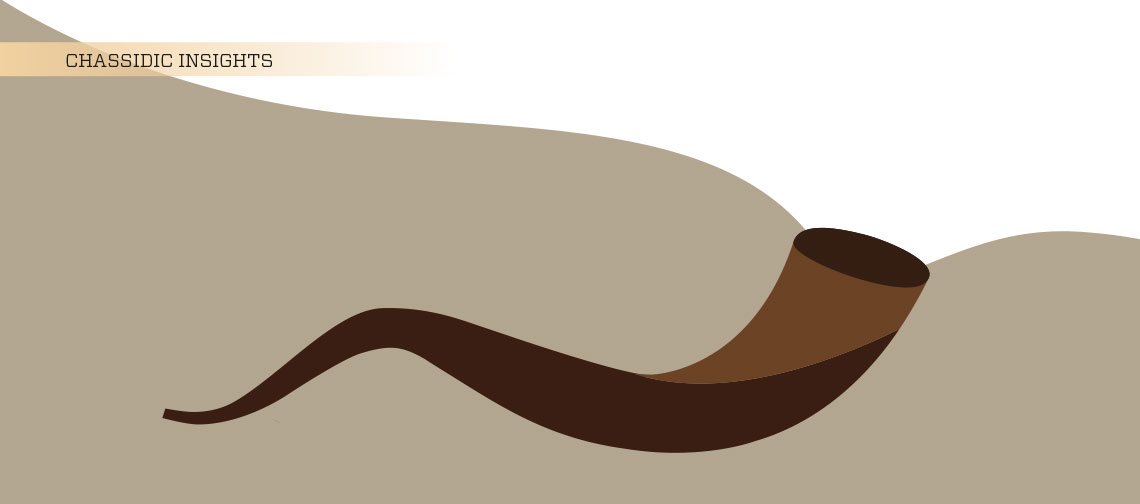The shofar is narrow on one end and broad on the other. The broad end is where the horn was attached to the animal’s head, and the narrow end is the tip of the horn. There are two rules in the Shulchan Aruch regarding the two ends of the shofar. One is that if someone mechanically changes the shape of the shofar by applying heat, making the narrow end wide and the wide end narrow, the shofar is pasul — disqualified. This is based on the Torah’s statement “veha’avarta shofar teruah” — “you shall sound the blast of a teruah,” in which the word “veha’avarta” teaches that it must be “derech ha’avarato” — “in the manner in which it is carried on the animal’s head”1 .
Another halachah states that even when one does not make any physical changes in the shofar, but merely reverses it and blows through the wide end, he does not fulfill the mitzvah. A hint to this halachah is found in the pasuk, “min hameitzar karati Kah annani bamerchav Kah” — “from the straights [lit. narrow] I called to Gd, and then Gd answered me with expansiveness [lit. wide open]”2 .
The first halachah is very easy to comprehend, but the second one is somewhat puzzling. To turn around a shofar and blow through the wide side, is extremely difficult. Why is one who exerts such effort to produce the prescribed tones rejected, receiving no credit for fulfilling the mitzvah?
When Bilaam was hired by Balak to curse the Jewish people, he said in amazement “Mah tovu ohalecha Yaakov mishkenosecha Yisrael” — “How goodly are your tents O Jacob, your dwelling places, O Israel”3 . Rashi comments that Bilaam was amazed when “he saw that the openings [of their tents] were not lined up with one opposite the other.” Why did he focus on their “openings”?
Rabbi Baruch of Mezibuz, a grandson of the Ba’al Shem Tov, explains it in the following way. The Midrash Rabbah4 says that Hashem urges the Jewish people to do teshuvah, saying: “Make a small opening like that of the head of a needle, and I will open for you an opening through which caravans can enter.” In other words, the Jew merely has to begin the teshuvah process, and Hashem will help him to attain the most lofty goals. Thus, the “openings” that Jews have to make and Hashem’s reciprocal opening are not comparable.
Therefore, in praise and envy Bilaam said, “You Jews are so lucky; your opening and Hashem’s opening are not ‘lined up’ — i.e. not identical — to each other. You only have to put in a little effort, and Hashem opens for you the vast gates of teshuvah. If your Gd loves you so much, how can my cursing possibly have an effect?”
The Rambam5 writes that though the sounding of the shofar on Rosh Hashanah is one of the six hundred and thirteen commandments of the Torah, it also conveys a call to the people to awaken from their slumber and do teshuvah — repent to Hashem.
It may be said that the two openings of the shofar, the narrow one and the wide one, represent the minute opening the Jew makes and the reciprocal broad opening of Hashem. While many may hesitate to do teshuvah, thinking that it is very difficult for one to return and come close to Hashem, the message of the shofar refutes this. It is simple to do teshuvah. Just make a small opening, move closer to Hashem, and He will open up His gates for you and facilitate your return.
The halachah about turning the shofar around and blowing through the wide end is a metaphor for those who preach that teshuvah is very difficult and that one must go through much effort in order to satisfy Hashem. This approach is contrary to our belief and, therefore, unacceptable and disqualified. The message conveyed by our way of blowing the shofar is that teshuvah is not difficult; a person simply has to make a small opening — a little effort — and he will reap immense reward.
The content in this page is produced by Chabad.org, and is copyrighted by the author and/or Chabad.org. If you enjoyed this article, we encourage you to distribute it further, provided that you do not revise any part of it, and you include this note, credit the author, and link to http://www.chabad.org/library/article_cdo/aid/2828497/jewish/The-Shape-of-the-Shofar.htm. If you wish to republish this article in a periodical, book, or website, please email [email protected].
1. Rosh Hashanah 27b, Orach Chaim 586:12.
2. Psalms 118:5.
3. Bamidbar 24:5.
4. Song of Songs 5:3.
5. Teshuvah 3:4.


 EN
EN  ZH
ZH  KR
KR  BR
BR  ES
ES  IN
IN  IL
IL 




